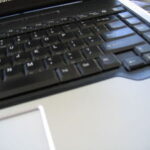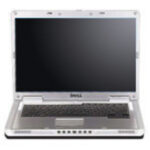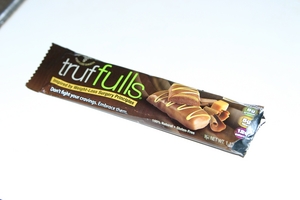The IBM Thinkpad 380D is a compact older laptop (notebook) computer with a Pentium processor. It remains fairly common and it is still quite possible to purchase accessories, parts, and software for it. Its shape is somewhat thick but not as long or wide as some laptops, and it weighs about seven pounds.
KEYBOARD: The Thinkpad 380D’s built-in keyboard is somewhat more like a stand-alone keyboard than some of the other laptops I have used. It has the arrow keys, function keys (F1 through F12), and INS/DEL/HOME/PGUP/etc. keys in separate areas from the rest of the keys, rather than having all of the keys in a single block. The space bar is somewhat small, and the ENTER key is located on the far right. There is no separate numeric keypad, but several letter keys can be used as a numeric keypad when “Num Lock” is turned on. There are seven orange and green indicator lights in a row below the built-in screen (power, hard drive activity, Num Lock, Scroll Lock, etc).
MOUSE & EXTERNAL KEYBOARD: The computer’s pointing device is a pencil eraser-like button in between the G, H, and B letter keys. It has two buttons centered in front of the spacebar, acting as the left/right buttons on a normal mouse do. I have found it more likely to cause wrist strain than a stand-alone mouse or touchpad-style laptop pointing device. The user’s guide indicates that an external numeric keypad or mouse/trackball can be connected to the computer’s PS/2 port. However, unlike on some laptops, an external keyboard cannot be attached to the laptop directly. Instead, a keyboard/mouse connector must be used, which allows an external mouse and keyboard to be connected at the same time. With an external CRT monitor also attached, the Thinkpad 380D can be set up as a compact desktop computer.
PORTS: In addition to the PS/2 port, the Thinkpad has three accessory ports on the back of it, covered by a removable plastic panel. There is a serial port, a parallel port, and a VGA monitor port. The serial and parallel ports can be used to connect most printers, scanners, some older digital cameras, and a variety of other devices. It does not have a USB port or game/joystick port (it may be possible to add one or both), making it impossible to use MP3 players, many digital cameras, joysticks, gamepads, and some of the other more recently-made accessories.
POWER: Other power supplies/adapters for it may be different, but the Thinkpad 380D I have used has an IBM model AA19650 power supply, which is very small and lightweight. It is more compact than the adapters of two other laptops I have used.
INTERNET: With the installation of a modem, this computer would probably run acceptably well on a dial-up connection, although you probably wouldn’t want to use it for large downloads or websites with many graphics. However, I have found 233 MHz or 333 MHz Pentium II processors to provide a noticeable improvement in dial-up internet speed, as compared to slower processors like that of the Thinkpad 380D. To some extent, (it seems to become less noticeable on speed increments over 333 MHz) the processor speed is almost as important as the connection/modem speed, because the computer has to process webpage code and images as it receives them over the internet. As for DSL internet access, Verizon DSL requires a 233 MHz or faster processor and Windows 98, making it unlikely to function on the Thinkpad 380D.
SOUND: The Thinkpad laptop has a built-in speaker and digital sound with headphone & microphone jacks. A convenient feature is that the volume for all sound can be adjusted using a radio-style dial on the side of the computer. The sound quality is good, although not as good as that of some other laptop and desktop computers I have used.
VIDEO: There is a built-in color display and a standard VGA port for connecting an external monitor. Using an external CRT monitor often provides better video quality than using the built-in screen on a laptop. The built-in display has a sliding brightness control and two latches (one on either side) for holding it shut against laptop base/keyboard when not in use.
MEMORY: This laptop was sold with 16MB of memory standard, but many units have been upgraded to greater amounts. Looking at eBay.com auction listings for the Thinkpad 380D, some now have 32MB, a few more than that. In general, most computers being used at present have somewhere between 96MB and 512MB of memory. However, it is still possible to use many pre-2000 software titles and operating systems with 16MB of memory, although this may reduce their capabilities or slow them down.
OPERATING SYSTEM: The Pentium 150MHz processor is capable of running Windows 95 fairly quickly, although Windows 3.x would likely run much faster. The Thinkpad User’s Guide states that the OS/2 Warp, IBM PC DOS 7.0, Windows 3.11, Windows 95, and Windows NT 3.51 & 4.0 operating systems are supported for the 380D. A sticker on the computer itself reads “Designed for Windows 95.” It also meets the system requirements for Windows 98, but does not meet the requirements for Windows XP, and would need a memory upgrade to use Windows ME (Millenium).
PURCHASE: Thinkpad 380D units are frequently available for purchase on eBay.com, and may occasionally appear in newspaper classifieds as well. Adapters, parts, and accessories for the 380D are also available on eBay.com, along with some websites which sell computer parts/supplies.
Overall, the Thinkpad 380D provides an inexpensive portable computing option which is still capable of accomplishing many types of computer tasks.




